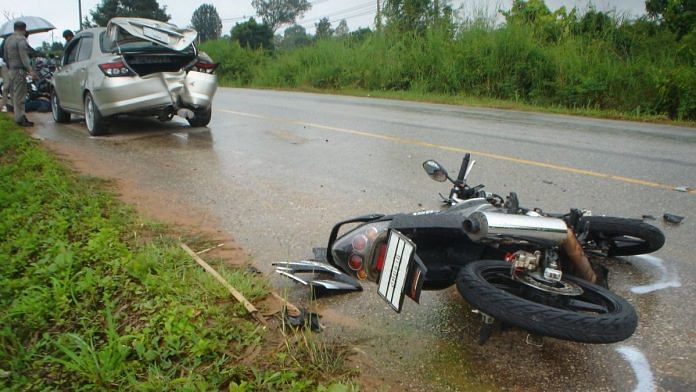Ganesh Raju, a 24-year-old business management student, was riding a motorbike in Hyderabad with his brother Chaitanya Verma, 22, on a Saturday evening in 2021. They crashed into a car and only Ganesh survived because he was wearing a helmet.
People who choose not to properly clasp their helmet, or not wear one at all, risk a life-threatening disaster. More than 69,000 motorcycle riders died in road crashes in 2021 across India, accounting for 45 per cent of all road crash deaths. Almost seven out of 10 of those killed were not wearing a clasped helmet, according to the Ministry of Road Transport and Highways (MoRTH) data. Helmets of correct standards, when clasped properly, significantly improve chances of survival during a crash. According to the World Health Organization (WHO), a correctly worn and certified quality helmet can reduce the risk of fatal injuries in a crash by 42 per cent and reduce risks of head injuries by 69 per cent. In the absence of a securely attached and ISI-marked good quality helmet as mandated by law, crash victims have far less chances of survival.
Motorcycle riders, along with pedestrians and auto-rickshaw occupants, are the most vulnerable road users in Delhi. Together they make up for four out five road crash deaths, motorcyclists accounting for 42 per cent of all crash deaths. They do not have the protective shell of a vehicle around them, leaving them at much higher risk of serious injury or death when involved in a crash.
Also read: Cyrus Mistry tragedy shows road safety is not limited to seatbelts
Helmet-clasping enforcement
In a country like India where motorbikes are a popular mode of commute, safety of riders must become a priority for all stakeholders. During a crash, a motorcycle rider takes the direct force of the colliding object and, in most instances, is thrown off of the bike. Without clasping, a helmet provides no protection to absorb the impact. In the 2021 Hyderabad road crash, wearing a clasped helmet may have saved the 22-year-old pillion rider Chaitanya’s life.
Proper helmet use can be increased through legislation and law enforcement. Implementing helmet laws has helped increase compliance in several countries. For example, helmet use among motorcyclists increased to nearly 90 per cent and above in Taiwan, Italy and the United States, a year after the introduction of helmet laws.
India, at the national level, has already outlined a path to reducing road crashes. It is one of 49 out of 167 countries to meet all five of WHO’s recommendations for a good helmet law. India’s Motor Vehicles Act 129 (b) mandates that both a motorcyclist and the pillion rider are required by law to wear a helmet and clasp it securely. The challenge is that the law is only effective if it is implemented and enforced.
Proper helmet use by pillion riders is still not implemented in several states despite the law. Delhi is one of the few places enforcing that pillion riders wear helmets. Helmet-clasping enforcement, however, is yet to be strictly implemented in the national capital.
Motorcycle riders won’t clasp their helmets if they know they can get away from the law and not get a challan. Often, riders either hold their helmets across their arms, or hang them on the two-wheeler handle and only wear it if they spot police nearby. Mass media campaigns, on television, billboards or social media, with sustained enforcement to inform the public about how properly fastened helmets have proven to help save lives can help spread awareness on the issue.
A 2022 study led by the John Hopkins International Injury Research Unit for the Delhi Transport Department shows that while 86 per cent of motorcycle occupants wore helmets, only 63 per cent of them clasped it properly. Furthermore, correct helmet use (standard helmets clasped properly) was lowest among pillion riders (43 per cent), and motorcycle occupants on arterial roads (39 per cent).
Reducing road crash deaths by 50 per cent is India’s commitment and the target for the United Nations’ Second Decade of Action for Road Safety. Nitin Gadkari, Union Minister of Road Transport and Highways hopes to meet that target by 2025. This goal is achievable by reducing speed, building safer infrastructure, and implementing existing laws including helmet-clasping.
The data is clear: wearing a clasped helmet saves lives. Using a safe systems approach and with support from relevant government and non-government stakeholders, making helmet clasping mandatory can prevent many tragic deaths in Delhi, and at the national level at large.
Dr. Nishit Patel is a research faculty at the Johns Hopkins International Injury Research Unit working with various injury prevention programs. Dr. Sara Whitehead is a public health physician with over 25 years’ experience with local, national, and
international institutions and leads road traffic injury surveillance system strengthening at global public health organization Vital Strategies as part of the Bloomberg Philanthropies Initiative for Global Road Safety.
(Edited by Ratan Priya)



